ECCWC401A Essay: Comparison of Australian Aboriginal Cultures
VerifiedAdded on 2022/12/29
|9
|2614
|67
Essay
AI Summary
This essay provides a comparative analysis of the Aboriginal and Torres Strait Islander cultures in Australia, highlighting their unique cultural practices, such as the Bora ceremony, Corroboree, and Smoking ceremony for Aboriginals, and the Dari head dress, kinship systems, and the Winds of Zenadth festival for Torres Strait Islanders. The essay further critiques the impact of colonization on these cultures, including the loss of land, rights, and the disruption of education systems. It also discusses the 'Eight Ways of Learning' strategy, which offers practical approaches to enhance the inclusion of Aboriginal and Torres Strait Islander children in education by incorporating community links, deconstruction/reconstruction of teaching methods, non-linear learning patterns, land links, non-verbal communication, story sharing, symbols and images, and learning maps, providing a comprehensive overview of the cultural dynamics and educational challenges faced by these communities.
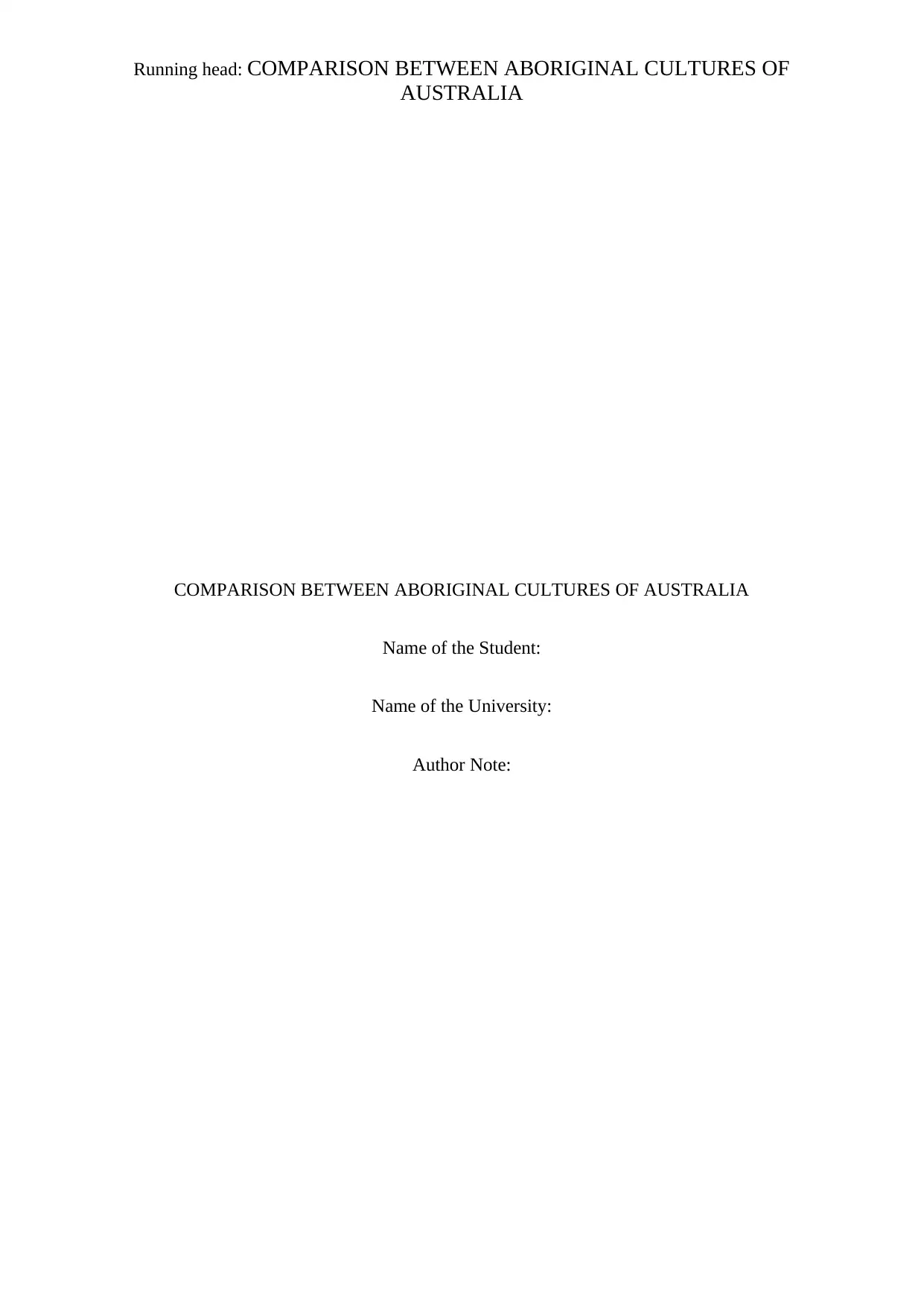
Running head: COMPARISON BETWEEN ABORIGINAL CULTURES OF
AUSTRALIA
COMPARISON BETWEEN ABORIGINAL CULTURES OF AUSTRALIA
Name of the Student:
Name of the University:
Author Note:
AUSTRALIA
COMPARISON BETWEEN ABORIGINAL CULTURES OF AUSTRALIA
Name of the Student:
Name of the University:
Author Note:
Paraphrase This Document
Need a fresh take? Get an instant paraphrase of this document with our AI Paraphraser
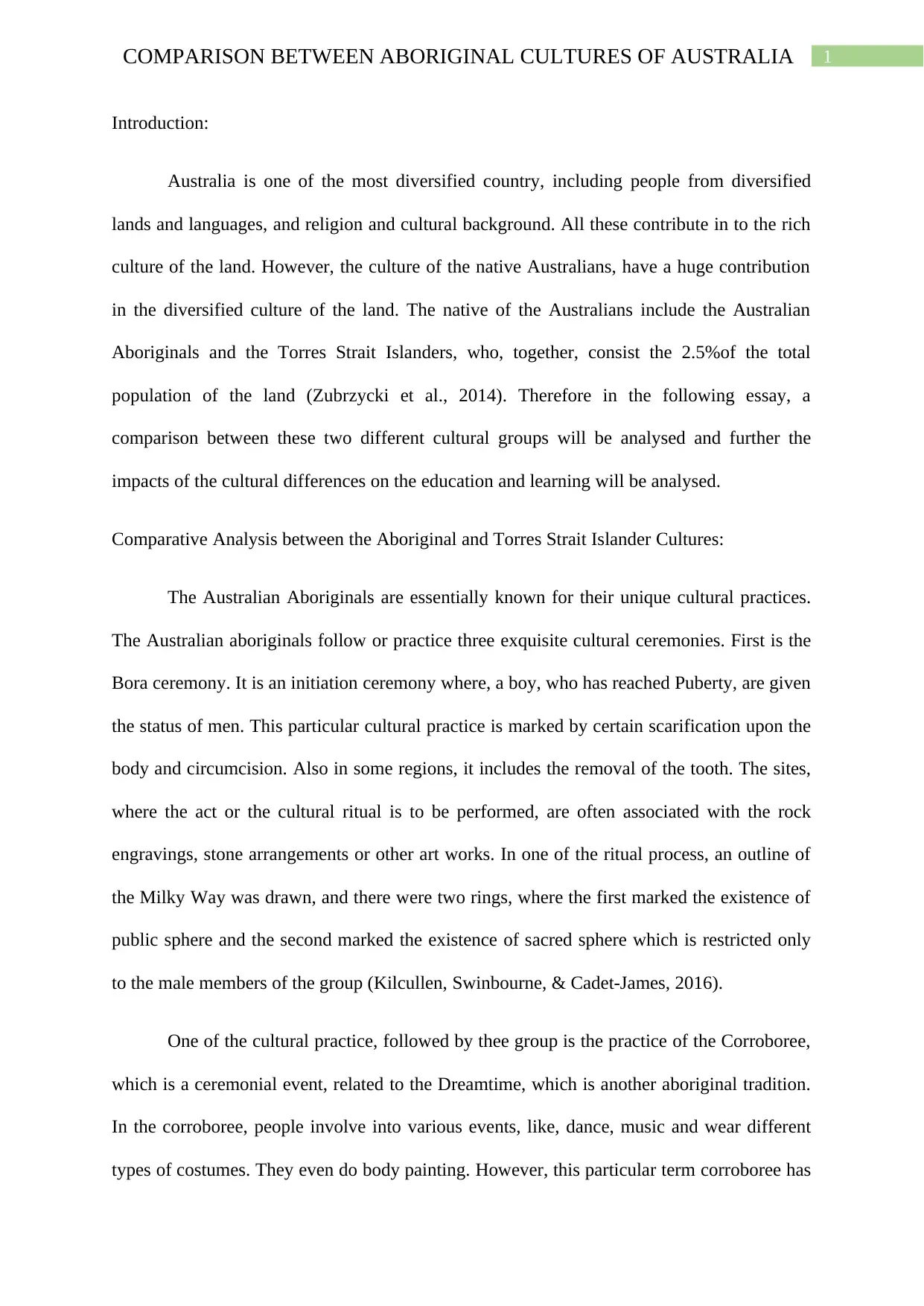
1COMPARISON BETWEEN ABORIGINAL CULTURES OF AUSTRALIA
Introduction:
Australia is one of the most diversified country, including people from diversified
lands and languages, and religion and cultural background. All these contribute in to the rich
culture of the land. However, the culture of the native Australians, have a huge contribution
in the diversified culture of the land. The native of the Australians include the Australian
Aboriginals and the Torres Strait Islanders, who, together, consist the 2.5%of the total
population of the land (Zubrzycki et al., 2014). Therefore in the following essay, a
comparison between these two different cultural groups will be analysed and further the
impacts of the cultural differences on the education and learning will be analysed.
Comparative Analysis between the Aboriginal and Torres Strait Islander Cultures:
The Australian Aboriginals are essentially known for their unique cultural practices.
The Australian aboriginals follow or practice three exquisite cultural ceremonies. First is the
Bora ceremony. It is an initiation ceremony where, a boy, who has reached Puberty, are given
the status of men. This particular cultural practice is marked by certain scarification upon the
body and circumcision. Also in some regions, it includes the removal of the tooth. The sites,
where the act or the cultural ritual is to be performed, are often associated with the rock
engravings, stone arrangements or other art works. In one of the ritual process, an outline of
the Milky Way was drawn, and there were two rings, where the first marked the existence of
public sphere and the second marked the existence of sacred sphere which is restricted only
to the male members of the group (Kilcullen, Swinbourne, & Cadet‐James, 2016).
One of the cultural practice, followed by thee group is the practice of the Corroboree,
which is a ceremonial event, related to the Dreamtime, which is another aboriginal tradition.
In the corroboree, people involve into various events, like, dance, music and wear different
types of costumes. They even do body painting. However, this particular term corroboree has
Introduction:
Australia is one of the most diversified country, including people from diversified
lands and languages, and religion and cultural background. All these contribute in to the rich
culture of the land. However, the culture of the native Australians, have a huge contribution
in the diversified culture of the land. The native of the Australians include the Australian
Aboriginals and the Torres Strait Islanders, who, together, consist the 2.5%of the total
population of the land (Zubrzycki et al., 2014). Therefore in the following essay, a
comparison between these two different cultural groups will be analysed and further the
impacts of the cultural differences on the education and learning will be analysed.
Comparative Analysis between the Aboriginal and Torres Strait Islander Cultures:
The Australian Aboriginals are essentially known for their unique cultural practices.
The Australian aboriginals follow or practice three exquisite cultural ceremonies. First is the
Bora ceremony. It is an initiation ceremony where, a boy, who has reached Puberty, are given
the status of men. This particular cultural practice is marked by certain scarification upon the
body and circumcision. Also in some regions, it includes the removal of the tooth. The sites,
where the act or the cultural ritual is to be performed, are often associated with the rock
engravings, stone arrangements or other art works. In one of the ritual process, an outline of
the Milky Way was drawn, and there were two rings, where the first marked the existence of
public sphere and the second marked the existence of sacred sphere which is restricted only
to the male members of the group (Kilcullen, Swinbourne, & Cadet‐James, 2016).
One of the cultural practice, followed by thee group is the practice of the Corroboree,
which is a ceremonial event, related to the Dreamtime, which is another aboriginal tradition.
In the corroboree, people involve into various events, like, dance, music and wear different
types of costumes. They even do body painting. However, this particular term corroboree has
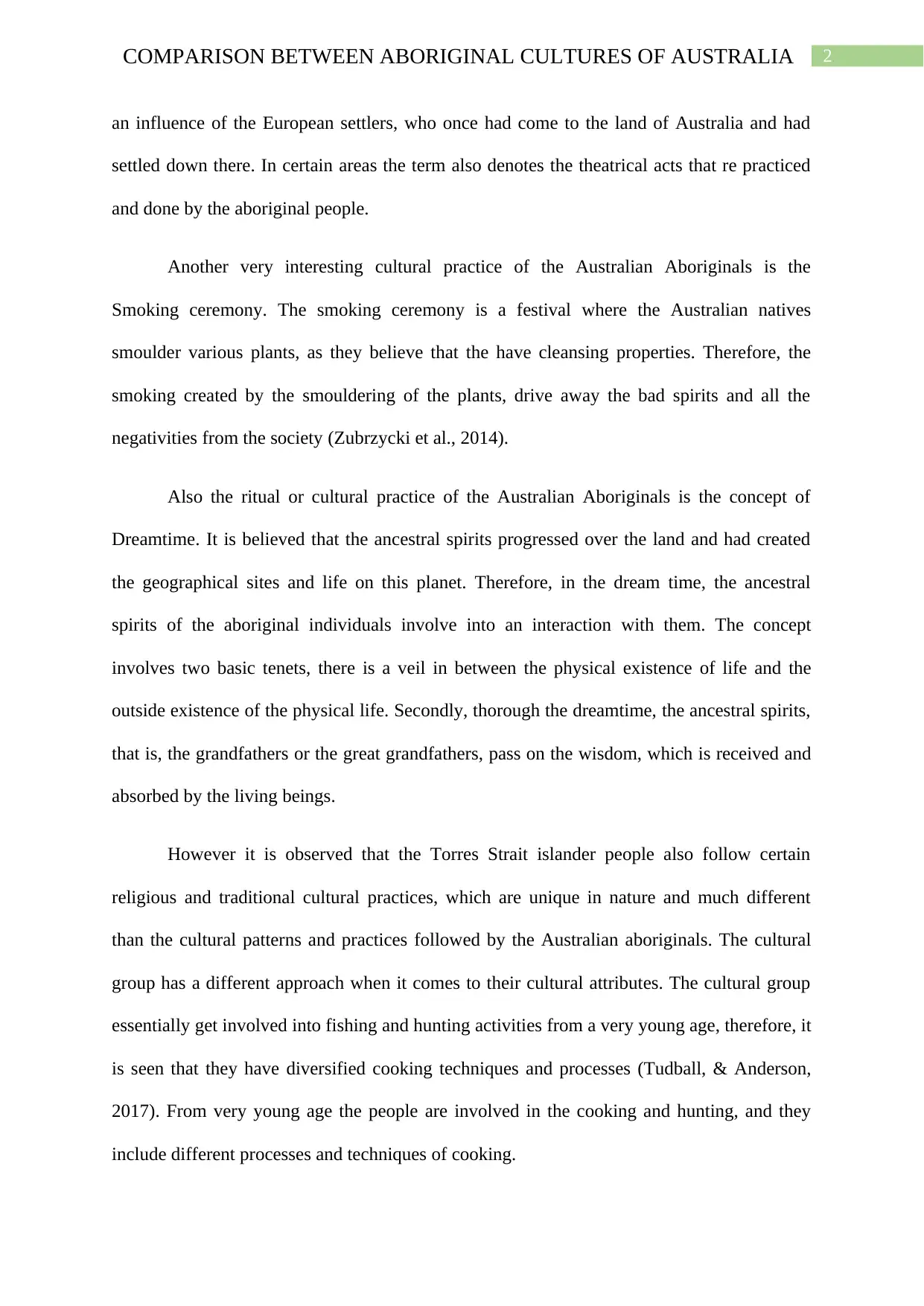
2COMPARISON BETWEEN ABORIGINAL CULTURES OF AUSTRALIA
an influence of the European settlers, who once had come to the land of Australia and had
settled down there. In certain areas the term also denotes the theatrical acts that re practiced
and done by the aboriginal people.
Another very interesting cultural practice of the Australian Aboriginals is the
Smoking ceremony. The smoking ceremony is a festival where the Australian natives
smoulder various plants, as they believe that the have cleansing properties. Therefore, the
smoking created by the smouldering of the plants, drive away the bad spirits and all the
negativities from the society (Zubrzycki et al., 2014).
Also the ritual or cultural practice of the Australian Aboriginals is the concept of
Dreamtime. It is believed that the ancestral spirits progressed over the land and had created
the geographical sites and life on this planet. Therefore, in the dream time, the ancestral
spirits of the aboriginal individuals involve into an interaction with them. The concept
involves two basic tenets, there is a veil in between the physical existence of life and the
outside existence of the physical life. Secondly, thorough the dreamtime, the ancestral spirits,
that is, the grandfathers or the great grandfathers, pass on the wisdom, which is received and
absorbed by the living beings.
However it is observed that the Torres Strait islander people also follow certain
religious and traditional cultural practices, which are unique in nature and much different
than the cultural patterns and practices followed by the Australian aboriginals. The cultural
group has a different approach when it comes to their cultural attributes. The cultural group
essentially get involved into fishing and hunting activities from a very young age, therefore, it
is seen that they have diversified cooking techniques and processes (Tudball, & Anderson,
2017). From very young age the people are involved in the cooking and hunting, and they
include different processes and techniques of cooking.
an influence of the European settlers, who once had come to the land of Australia and had
settled down there. In certain areas the term also denotes the theatrical acts that re practiced
and done by the aboriginal people.
Another very interesting cultural practice of the Australian Aboriginals is the
Smoking ceremony. The smoking ceremony is a festival where the Australian natives
smoulder various plants, as they believe that the have cleansing properties. Therefore, the
smoking created by the smouldering of the plants, drive away the bad spirits and all the
negativities from the society (Zubrzycki et al., 2014).
Also the ritual or cultural practice of the Australian Aboriginals is the concept of
Dreamtime. It is believed that the ancestral spirits progressed over the land and had created
the geographical sites and life on this planet. Therefore, in the dream time, the ancestral
spirits of the aboriginal individuals involve into an interaction with them. The concept
involves two basic tenets, there is a veil in between the physical existence of life and the
outside existence of the physical life. Secondly, thorough the dreamtime, the ancestral spirits,
that is, the grandfathers or the great grandfathers, pass on the wisdom, which is received and
absorbed by the living beings.
However it is observed that the Torres Strait islander people also follow certain
religious and traditional cultural practices, which are unique in nature and much different
than the cultural patterns and practices followed by the Australian aboriginals. The cultural
group has a different approach when it comes to their cultural attributes. The cultural group
essentially get involved into fishing and hunting activities from a very young age, therefore, it
is seen that they have diversified cooking techniques and processes (Tudball, & Anderson,
2017). From very young age the people are involved in the cooking and hunting, and they
include different processes and techniques of cooking.
⊘ This is a preview!⊘
Do you want full access?
Subscribe today to unlock all pages.

Trusted by 1+ million students worldwide
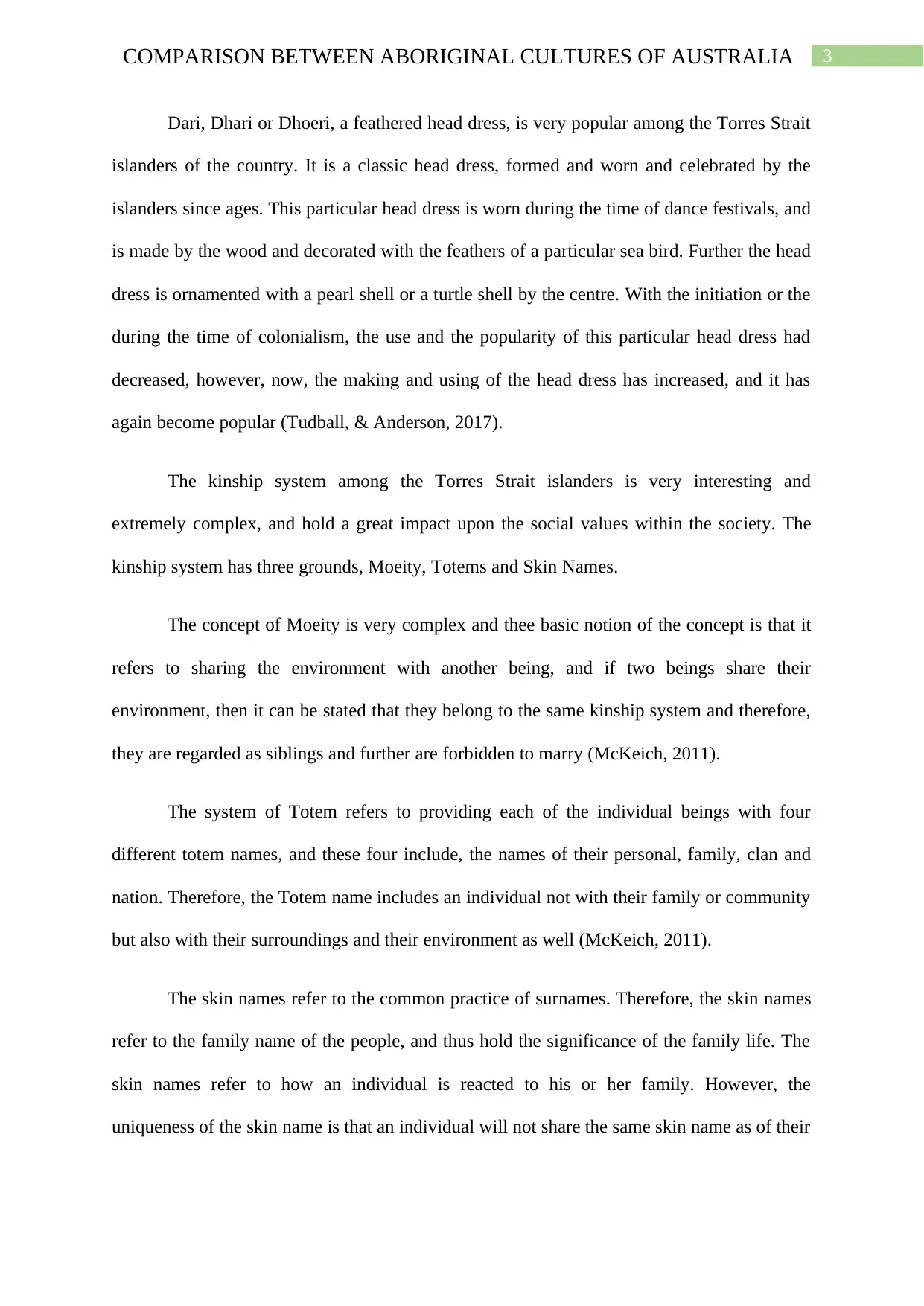
3COMPARISON BETWEEN ABORIGINAL CULTURES OF AUSTRALIA
Dari, Dhari or Dhoeri, a feathered head dress, is very popular among the Torres Strait
islanders of the country. It is a classic head dress, formed and worn and celebrated by the
islanders since ages. This particular head dress is worn during the time of dance festivals, and
is made by the wood and decorated with the feathers of a particular sea bird. Further the head
dress is ornamented with a pearl shell or a turtle shell by the centre. With the initiation or the
during the time of colonialism, the use and the popularity of this particular head dress had
decreased, however, now, the making and using of the head dress has increased, and it has
again become popular (Tudball, & Anderson, 2017).
The kinship system among the Torres Strait islanders is very interesting and
extremely complex, and hold a great impact upon the social values within the society. The
kinship system has three grounds, Moeity, Totems and Skin Names.
The concept of Moeity is very complex and thee basic notion of the concept is that it
refers to sharing the environment with another being, and if two beings share their
environment, then it can be stated that they belong to the same kinship system and therefore,
they are regarded as siblings and further are forbidden to marry (McKeich, 2011).
The system of Totem refers to providing each of the individual beings with four
different totem names, and these four include, the names of their personal, family, clan and
nation. Therefore, the Totem name includes an individual not with their family or community
but also with their surroundings and their environment as well (McKeich, 2011).
The skin names refer to the common practice of surnames. Therefore, the skin names
refer to the family name of the people, and thus hold the significance of the family life. The
skin names refer to how an individual is reacted to his or her family. However, the
uniqueness of the skin name is that an individual will not share the same skin name as of their
Dari, Dhari or Dhoeri, a feathered head dress, is very popular among the Torres Strait
islanders of the country. It is a classic head dress, formed and worn and celebrated by the
islanders since ages. This particular head dress is worn during the time of dance festivals, and
is made by the wood and decorated with the feathers of a particular sea bird. Further the head
dress is ornamented with a pearl shell or a turtle shell by the centre. With the initiation or the
during the time of colonialism, the use and the popularity of this particular head dress had
decreased, however, now, the making and using of the head dress has increased, and it has
again become popular (Tudball, & Anderson, 2017).
The kinship system among the Torres Strait islanders is very interesting and
extremely complex, and hold a great impact upon the social values within the society. The
kinship system has three grounds, Moeity, Totems and Skin Names.
The concept of Moeity is very complex and thee basic notion of the concept is that it
refers to sharing the environment with another being, and if two beings share their
environment, then it can be stated that they belong to the same kinship system and therefore,
they are regarded as siblings and further are forbidden to marry (McKeich, 2011).
The system of Totem refers to providing each of the individual beings with four
different totem names, and these four include, the names of their personal, family, clan and
nation. Therefore, the Totem name includes an individual not with their family or community
but also with their surroundings and their environment as well (McKeich, 2011).
The skin names refer to the common practice of surnames. Therefore, the skin names
refer to the family name of the people, and thus hold the significance of the family life. The
skin names refer to how an individual is reacted to his or her family. However, the
uniqueness of the skin name is that an individual will not share the same skin name as of their
Paraphrase This Document
Need a fresh take? Get an instant paraphrase of this document with our AI Paraphraser
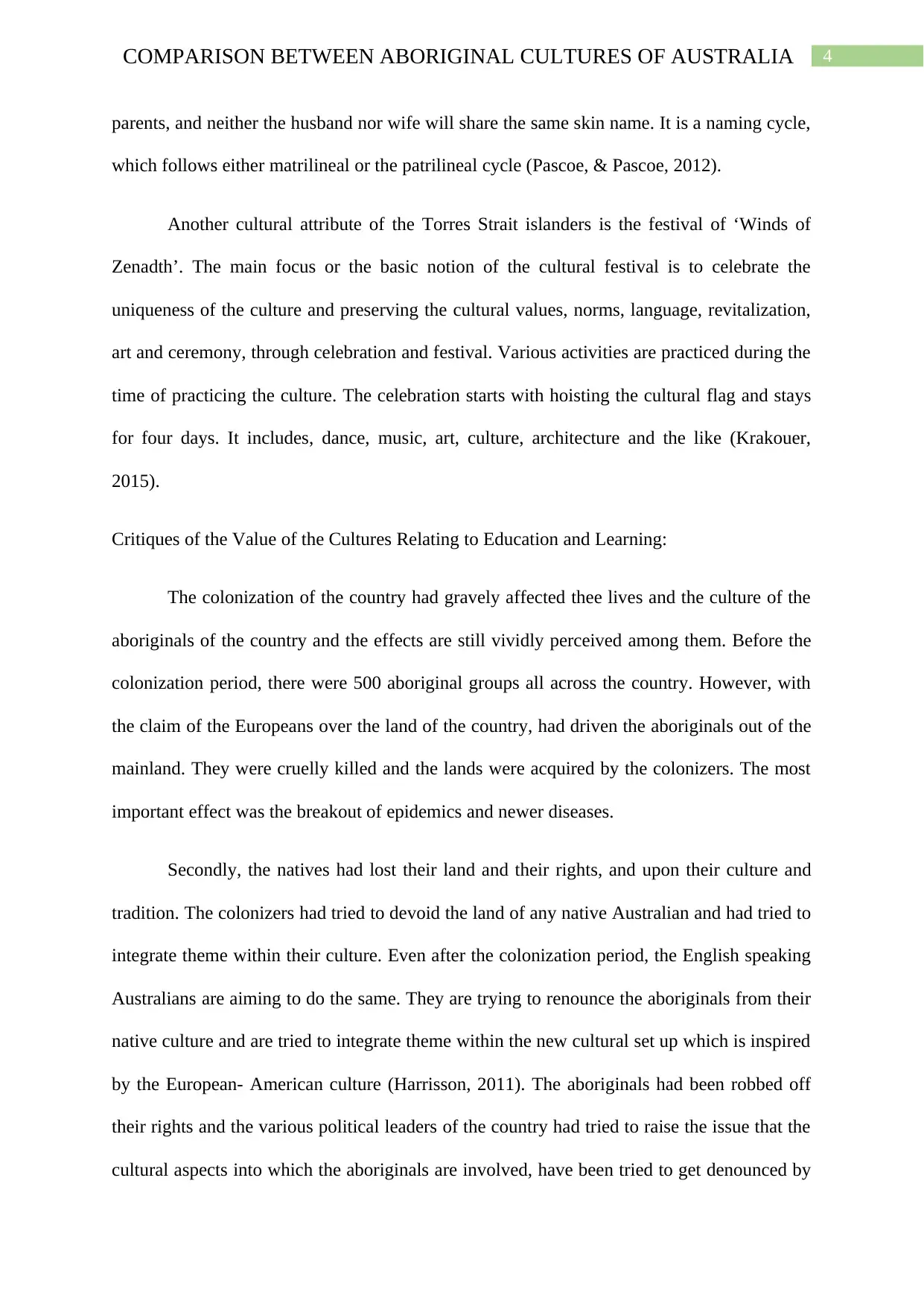
4COMPARISON BETWEEN ABORIGINAL CULTURES OF AUSTRALIA
parents, and neither the husband nor wife will share the same skin name. It is a naming cycle,
which follows either matrilineal or the patrilineal cycle (Pascoe, & Pascoe, 2012).
Another cultural attribute of the Torres Strait islanders is the festival of ‘Winds of
Zenadth’. The main focus or the basic notion of the cultural festival is to celebrate the
uniqueness of the culture and preserving the cultural values, norms, language, revitalization,
art and ceremony, through celebration and festival. Various activities are practiced during the
time of practicing the culture. The celebration starts with hoisting the cultural flag and stays
for four days. It includes, dance, music, art, culture, architecture and the like (Krakouer,
2015).
Critiques of the Value of the Cultures Relating to Education and Learning:
The colonization of the country had gravely affected thee lives and the culture of the
aboriginals of the country and the effects are still vividly perceived among them. Before the
colonization period, there were 500 aboriginal groups all across the country. However, with
the claim of the Europeans over the land of the country, had driven the aboriginals out of the
mainland. They were cruelly killed and the lands were acquired by the colonizers. The most
important effect was the breakout of epidemics and newer diseases.
Secondly, the natives had lost their land and their rights, and upon their culture and
tradition. The colonizers had tried to devoid the land of any native Australian and had tried to
integrate theme within their culture. Even after the colonization period, the English speaking
Australians are aiming to do the same. They are trying to renounce the aboriginals from their
native culture and are tried to integrate theme within the new cultural set up which is inspired
by the European- American culture (Harrisson, 2011). The aboriginals had been robbed off
their rights and the various political leaders of the country had tried to raise the issue that the
cultural aspects into which the aboriginals are involved, have been tried to get denounced by
parents, and neither the husband nor wife will share the same skin name. It is a naming cycle,
which follows either matrilineal or the patrilineal cycle (Pascoe, & Pascoe, 2012).
Another cultural attribute of the Torres Strait islanders is the festival of ‘Winds of
Zenadth’. The main focus or the basic notion of the cultural festival is to celebrate the
uniqueness of the culture and preserving the cultural values, norms, language, revitalization,
art and ceremony, through celebration and festival. Various activities are practiced during the
time of practicing the culture. The celebration starts with hoisting the cultural flag and stays
for four days. It includes, dance, music, art, culture, architecture and the like (Krakouer,
2015).
Critiques of the Value of the Cultures Relating to Education and Learning:
The colonization of the country had gravely affected thee lives and the culture of the
aboriginals of the country and the effects are still vividly perceived among them. Before the
colonization period, there were 500 aboriginal groups all across the country. However, with
the claim of the Europeans over the land of the country, had driven the aboriginals out of the
mainland. They were cruelly killed and the lands were acquired by the colonizers. The most
important effect was the breakout of epidemics and newer diseases.
Secondly, the natives had lost their land and their rights, and upon their culture and
tradition. The colonizers had tried to devoid the land of any native Australian and had tried to
integrate theme within their culture. Even after the colonization period, the English speaking
Australians are aiming to do the same. They are trying to renounce the aboriginals from their
native culture and are tried to integrate theme within the new cultural set up which is inspired
by the European- American culture (Harrisson, 2011). The aboriginals had been robbed off
their rights and the various political leaders of the country had tried to raise the issue that the
cultural aspects into which the aboriginals are involved, have been tried to get denounced by

5COMPARISON BETWEEN ABORIGINAL CULTURES OF AUSTRALIA
them. The aboriginal culture and tradition are seen as superstitious and orthodox and it is
believed that they should not get practiced any more.
Thirdly, there was a huge impact on the education system of the people. With lesser
resources, it became difficult for them to survive, therefore, immediately, the educational
system were completely ruined, for this cultural group. After the colonization period, the
majority of the population were consisted of the English speaking Australians, therefore,
there was a huge language and a communication gap between the native aboriginal and the
English speaking Australians. The trauma caused by the colonizers are still very much
effective upon the aboriginals of the country, as they are still exploited and abandoned
(Funston, & Herring, 2016). They were robbed off their rights and the educational and the
communication gap which had been created because of the colonization, are effectively and
increasingly impacting upon the economic and daily life of the native countrymen.
Eight Ways of Learning strategy to Enable Inclusion of ATSI Children in Education:
Since the aboriginal students find it difficult to get included within the educational system
and pattern that is practiced in the mainland of Australia, therefore, according to the social
researchers, it is important to include theme within the scaffolds of the educational patterns,
practiced in the mainland of Australia. Therefore, the following right strategies can be
included in order to increase the participation of the aboriginal children within the learning
pattern and to include the children within the same.
Community Links: The educational institution must include a diversified approach
and include the community sense within the curriculum to encourage the aboriginal
people and to include the aboriginal children within the institutional pattern (Banks,
2015). They must promote the need for education among the aboriginal children and
them. The aboriginal culture and tradition are seen as superstitious and orthodox and it is
believed that they should not get practiced any more.
Thirdly, there was a huge impact on the education system of the people. With lesser
resources, it became difficult for them to survive, therefore, immediately, the educational
system were completely ruined, for this cultural group. After the colonization period, the
majority of the population were consisted of the English speaking Australians, therefore,
there was a huge language and a communication gap between the native aboriginal and the
English speaking Australians. The trauma caused by the colonizers are still very much
effective upon the aboriginals of the country, as they are still exploited and abandoned
(Funston, & Herring, 2016). They were robbed off their rights and the educational and the
communication gap which had been created because of the colonization, are effectively and
increasingly impacting upon the economic and daily life of the native countrymen.
Eight Ways of Learning strategy to Enable Inclusion of ATSI Children in Education:
Since the aboriginal students find it difficult to get included within the educational system
and pattern that is practiced in the mainland of Australia, therefore, according to the social
researchers, it is important to include theme within the scaffolds of the educational patterns,
practiced in the mainland of Australia. Therefore, the following right strategies can be
included in order to increase the participation of the aboriginal children within the learning
pattern and to include the children within the same.
Community Links: The educational institution must include a diversified approach
and include the community sense within the curriculum to encourage the aboriginal
people and to include the aboriginal children within the institutional pattern (Banks,
2015). They must promote the need for education among the aboriginal children and
⊘ This is a preview!⊘
Do you want full access?
Subscribe today to unlock all pages.

Trusted by 1+ million students worldwide
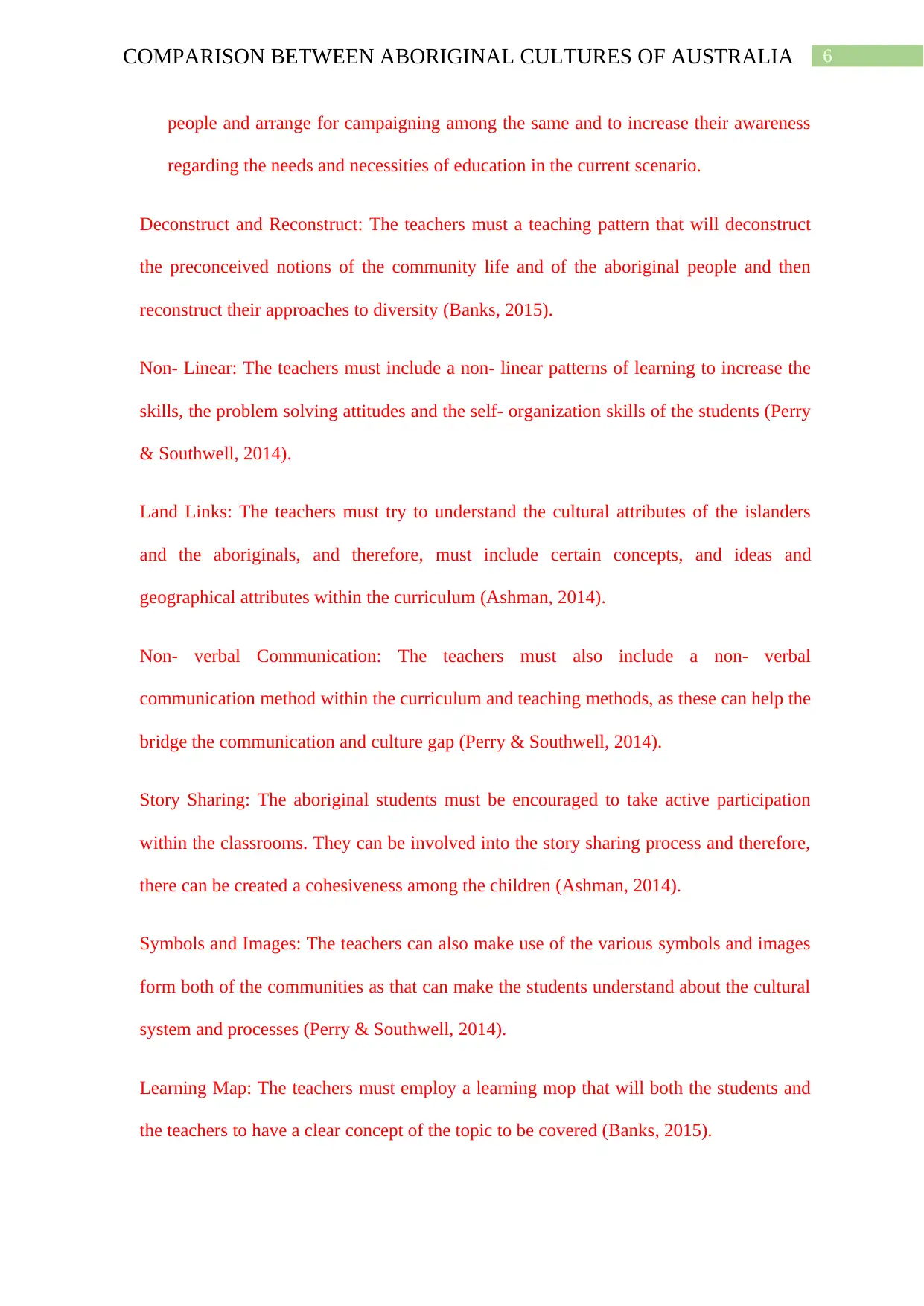
6COMPARISON BETWEEN ABORIGINAL CULTURES OF AUSTRALIA
people and arrange for campaigning among the same and to increase their awareness
regarding the needs and necessities of education in the current scenario.
Deconstruct and Reconstruct: The teachers must a teaching pattern that will deconstruct
the preconceived notions of the community life and of the aboriginal people and then
reconstruct their approaches to diversity (Banks, 2015).
Non- Linear: The teachers must include a non- linear patterns of learning to increase the
skills, the problem solving attitudes and the self- organization skills of the students (Perry
& Southwell, 2014).
Land Links: The teachers must try to understand the cultural attributes of the islanders
and the aboriginals, and therefore, must include certain concepts, and ideas and
geographical attributes within the curriculum (Ashman, 2014).
Non- verbal Communication: The teachers must also include a non- verbal
communication method within the curriculum and teaching methods, as these can help the
bridge the communication and culture gap (Perry & Southwell, 2014).
Story Sharing: The aboriginal students must be encouraged to take active participation
within the classrooms. They can be involved into the story sharing process and therefore,
there can be created a cohesiveness among the children (Ashman, 2014).
Symbols and Images: The teachers can also make use of the various symbols and images
form both of the communities as that can make the students understand about the cultural
system and processes (Perry & Southwell, 2014).
Learning Map: The teachers must employ a learning mop that will both the students and
the teachers to have a clear concept of the topic to be covered (Banks, 2015).
people and arrange for campaigning among the same and to increase their awareness
regarding the needs and necessities of education in the current scenario.
Deconstruct and Reconstruct: The teachers must a teaching pattern that will deconstruct
the preconceived notions of the community life and of the aboriginal people and then
reconstruct their approaches to diversity (Banks, 2015).
Non- Linear: The teachers must include a non- linear patterns of learning to increase the
skills, the problem solving attitudes and the self- organization skills of the students (Perry
& Southwell, 2014).
Land Links: The teachers must try to understand the cultural attributes of the islanders
and the aboriginals, and therefore, must include certain concepts, and ideas and
geographical attributes within the curriculum (Ashman, 2014).
Non- verbal Communication: The teachers must also include a non- verbal
communication method within the curriculum and teaching methods, as these can help the
bridge the communication and culture gap (Perry & Southwell, 2014).
Story Sharing: The aboriginal students must be encouraged to take active participation
within the classrooms. They can be involved into the story sharing process and therefore,
there can be created a cohesiveness among the children (Ashman, 2014).
Symbols and Images: The teachers can also make use of the various symbols and images
form both of the communities as that can make the students understand about the cultural
system and processes (Perry & Southwell, 2014).
Learning Map: The teachers must employ a learning mop that will both the students and
the teachers to have a clear concept of the topic to be covered (Banks, 2015).
Paraphrase This Document
Need a fresh take? Get an instant paraphrase of this document with our AI Paraphraser
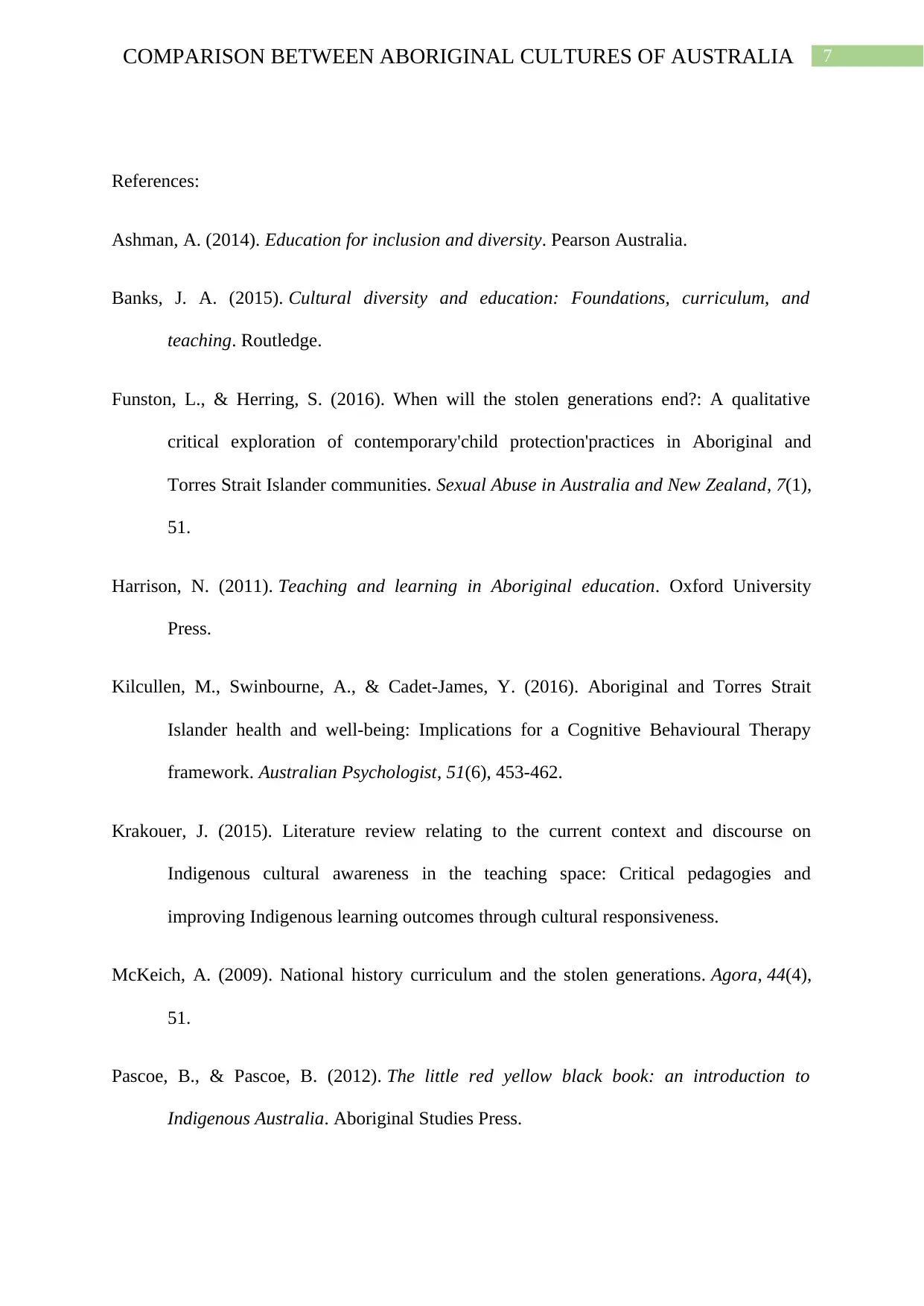
7COMPARISON BETWEEN ABORIGINAL CULTURES OF AUSTRALIA
References:
Ashman, A. (2014). Education for inclusion and diversity. Pearson Australia.
Banks, J. A. (2015). Cultural diversity and education: Foundations, curriculum, and
teaching. Routledge.
Funston, L., & Herring, S. (2016). When will the stolen generations end?: A qualitative
critical exploration of contemporary'child protection'practices in Aboriginal and
Torres Strait Islander communities. Sexual Abuse in Australia and New Zealand, 7(1),
51.
Harrison, N. (2011). Teaching and learning in Aboriginal education. Oxford University
Press.
Kilcullen, M., Swinbourne, A., & Cadet‐James, Y. (2016). Aboriginal and Torres Strait
Islander health and well‐being: Implications for a Cognitive Behavioural Therapy
framework. Australian Psychologist, 51(6), 453-462.
Krakouer, J. (2015). Literature review relating to the current context and discourse on
Indigenous cultural awareness in the teaching space: Critical pedagogies and
improving Indigenous learning outcomes through cultural responsiveness.
McKeich, A. (2009). National history curriculum and the stolen generations. Agora, 44(4),
51.
Pascoe, B., & Pascoe, B. (2012). The little red yellow black book: an introduction to
Indigenous Australia. Aboriginal Studies Press.
References:
Ashman, A. (2014). Education for inclusion and diversity. Pearson Australia.
Banks, J. A. (2015). Cultural diversity and education: Foundations, curriculum, and
teaching. Routledge.
Funston, L., & Herring, S. (2016). When will the stolen generations end?: A qualitative
critical exploration of contemporary'child protection'practices in Aboriginal and
Torres Strait Islander communities. Sexual Abuse in Australia and New Zealand, 7(1),
51.
Harrison, N. (2011). Teaching and learning in Aboriginal education. Oxford University
Press.
Kilcullen, M., Swinbourne, A., & Cadet‐James, Y. (2016). Aboriginal and Torres Strait
Islander health and well‐being: Implications for a Cognitive Behavioural Therapy
framework. Australian Psychologist, 51(6), 453-462.
Krakouer, J. (2015). Literature review relating to the current context and discourse on
Indigenous cultural awareness in the teaching space: Critical pedagogies and
improving Indigenous learning outcomes through cultural responsiveness.
McKeich, A. (2009). National history curriculum and the stolen generations. Agora, 44(4),
51.
Pascoe, B., & Pascoe, B. (2012). The little red yellow black book: an introduction to
Indigenous Australia. Aboriginal Studies Press.
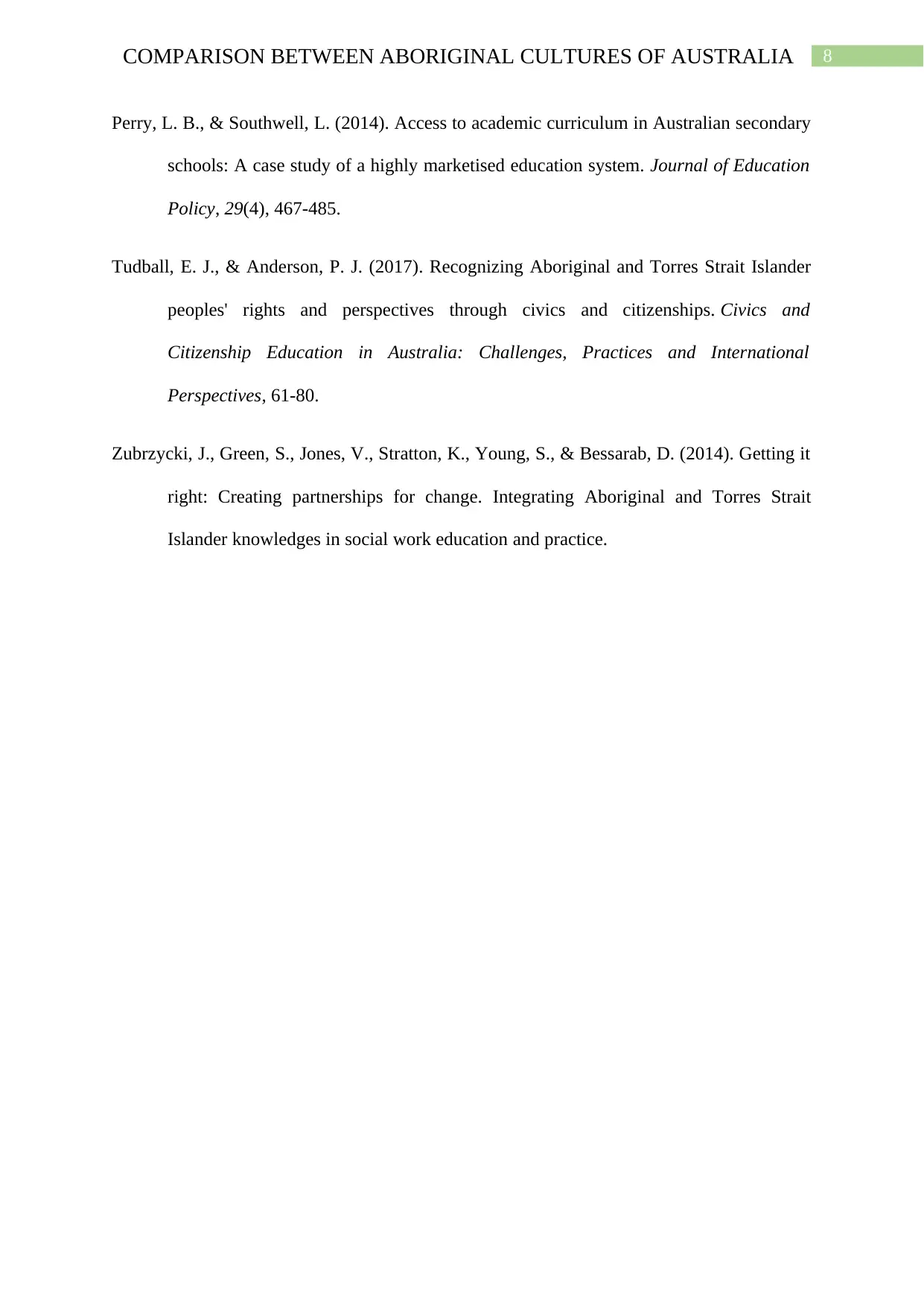
8COMPARISON BETWEEN ABORIGINAL CULTURES OF AUSTRALIA
Perry, L. B., & Southwell, L. (2014). Access to academic curriculum in Australian secondary
schools: A case study of a highly marketised education system. Journal of Education
Policy, 29(4), 467-485.
Tudball, E. J., & Anderson, P. J. (2017). Recognizing Aboriginal and Torres Strait Islander
peoples' rights and perspectives through civics and citizenships. Civics and
Citizenship Education in Australia: Challenges, Practices and International
Perspectives, 61-80.
Zubrzycki, J., Green, S., Jones, V., Stratton, K., Young, S., & Bessarab, D. (2014). Getting it
right: Creating partnerships for change. Integrating Aboriginal and Torres Strait
Islander knowledges in social work education and practice.
Perry, L. B., & Southwell, L. (2014). Access to academic curriculum in Australian secondary
schools: A case study of a highly marketised education system. Journal of Education
Policy, 29(4), 467-485.
Tudball, E. J., & Anderson, P. J. (2017). Recognizing Aboriginal and Torres Strait Islander
peoples' rights and perspectives through civics and citizenships. Civics and
Citizenship Education in Australia: Challenges, Practices and International
Perspectives, 61-80.
Zubrzycki, J., Green, S., Jones, V., Stratton, K., Young, S., & Bessarab, D. (2014). Getting it
right: Creating partnerships for change. Integrating Aboriginal and Torres Strait
Islander knowledges in social work education and practice.
⊘ This is a preview!⊘
Do you want full access?
Subscribe today to unlock all pages.

Trusted by 1+ million students worldwide
1 out of 9
Related Documents
Your All-in-One AI-Powered Toolkit for Academic Success.
+13062052269
info@desklib.com
Available 24*7 on WhatsApp / Email
![[object Object]](/_next/static/media/star-bottom.7253800d.svg)
Unlock your academic potential
Copyright © 2020–2025 A2Z Services. All Rights Reserved. Developed and managed by ZUCOL.





